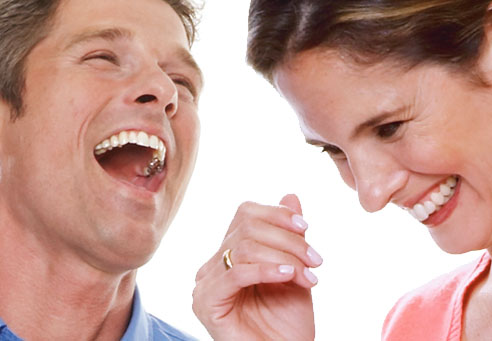|
Men & Women
By Bryon Verhaeghe
September 2004
 Health is described as the well being of our physical, mental, and social state, and not just the absence of sickness and disease. In my studies of the physical health of the body I am constantly reminded of the differences between men and women. Some diseases progress faster in women and some faster in men. Some diseases are more common in men or women and even a few are exclusive to a gender. What I can’t help notice all the time is that women outlive men and need less intervention to achieve this. Men have more hearing problems and have higher rates of hearing aids and deafness. Earlier in life we joke about men having selective hearing when in fact they have reduced hearing. In men multiple sclerosis advances more aggressively and faster than in women. Women have higher rates of breast cancer. The differences in health and life span intrigue me. As I study physical health and how to maintain it I feel that there are some key clues by looking closer at the differences between men and women in relation to health. Health is described as the well being of our physical, mental, and social state, and not just the absence of sickness and disease. In my studies of the physical health of the body I am constantly reminded of the differences between men and women. Some diseases progress faster in women and some faster in men. Some diseases are more common in men or women and even a few are exclusive to a gender. What I can’t help notice all the time is that women outlive men and need less intervention to achieve this. Men have more hearing problems and have higher rates of hearing aids and deafness. Earlier in life we joke about men having selective hearing when in fact they have reduced hearing. In men multiple sclerosis advances more aggressively and faster than in women. Women have higher rates of breast cancer. The differences in health and life span intrigue me. As I study physical health and how to maintain it I feel that there are some key clues by looking closer at the differences between men and women in relation to health.
One of the key differences develops during the growth of the fetus in pregnancy. This is specific when the gonad of the male descends down to become the testicle and is attached to the outside by a long canal (urethra) that carries urine. Urine is produced in mammals as advancement to the immune system. Reptiles expel uric acid and are unable to produce urine. People with low levels of urea are more susceptible to multiple sclerosis.
In the female the gonad moves up to become the ovary and detaches from the outside so that bacteria are unable to reach it. This detachment is necessary because the antibacterial properties of urine are not present in the female reproductive tract. This space is incorporated as part of the immune system to protect the ovary from bacteria. This is necessary so that the fertilized egg may attach to the uterus for pregnancy. If urine were present the pregnancy would not occur because the urine is protection from tiny animals, including bacteria. The fertilized egg would be unable to attach to the mother if urine were present. Because there is no urine in this area of the female there is a high level of ‘flora’ (ba
cteria). To protect the ovary it is detached from this system and the outside so that bacteria can’t get across to it. This is an enhanced immune function in women. In addition to these physical immune differences there are the hormone differences to further enhance the female immune system.
We are born with very soft and flexible bone that has low levels of calcium. The flexibility is to facilitate the rigors of passing through the birth canal without breaking. When you give excess calcium to pregnant lab animals the offspring are often born with cleft palate or stillborn. As we grow, our bones lay down calcium bound to phosphorus from the center outwardly. The portion that is mostly cartilage is the part of the bone that grows and the calcified portion grows very little. Hormones control this calcification. The estrogen in females calcifies bones slower than testosterone in males. This is important so that the female pelvis can grow more and become larger than a male pelvis to facilitate childbirth. The pubic bone of a women remains with cartilage until menopause so that it can expand for childbirth. Testosterone attracts calcium faster to the bones. This causes the pelvic bone in males to calcify faster and ends up being smaller. To ensure that the pubic bone in men calcifies fully the prostate is located directly behind the pubic bone. This gland concentrates testosterone around the pubic bone and ensures bone formation to strengthen the pelvic girdle. This allow
s a faster and stronger male for the work of providing food and shelter.
The down side of all of this is that estrogen happens to stimulate the rapid growth of yeast. When a woman becomes sexually active and develops a yeast infection, the yeast actually came from the man in the sperm. In the man, testosterone keeps yeast quiet and once in the woman the estrogen blooms it. In men we see higher rates of athlete’s foot and jock itch. The jock itch is the area where the nerves travel to the genitals. Newer diagnostic techniques with DNA testing are showing that yeast is the most common cause of prostatitis. This is why it is so chronic and difficult to get rid of. Antibiotics are not very effective against yeast.
Sinus problems are higher in men. The sinus cavities are below the brain so that the brain is protected from cold temperatures. We all remember ‘brain freeze’ from cold ice cream or ice water. When it is cold outside we breathe in cold air and our eyes get very cold but we do not get ‘brain freeze’. Below the brain are many cavities to protect it from cold. The ears occupy a space that is very similar to a sinus cavity. In a study it was determined that yeast is the most common cause of sinus infection in men. The yeast are able to travel from one sinus cavity to another and skip from the nose area over to the ear area and give men the selective hearing syndrome and hearing aides later in life.
The largest sinus cavity is the one above the nose to protect the brain from the cold air. Just behind this cavity are the language centers of the brain. When this cavity develops a mild infection the toxins leak into the brain and conversational skills are reduced along with short-term memory. This is seen with older people having more trouble remembering where their keys are and forgetting mid sentence what they were talking about. Often men get a larger furrow ridge on their forehead near their eyebrows and speech problems. Sometimes we call a man the strong quiet type. Men have slower speech speed.
Why do men have the yeast problems associated with athlete’s foot, jock itch, and dandruff leading to baldness, prostatitis, hearing loss? It is the women who have the estrogen that blooms yeast. Yet women outlive men and enjoy a better quality of health. What we need to understand is that females are more important for the survival of our species than males. A female is only able to reproduce comfortably once per year while a man is physically able to reproduce every three days. This in a statistical viewpoint would indicate that for every 100 women we only need 1 man. Men are less needed for the reproductive survival of the species.
Women get an extra hormone. A woman’s monthly hormonal cycle has elevated levels of estrogen to enlarge the breasts and thicken the lining of the uterus in preparation for pregnancy. The ovaries swell, begin producing progesterone and release an egg. The

egg floats to the fallopian tube. Fallopian in Latin means ‘flower’. It was named this because is looks like a flower with an open top like a funnel to catch the egg. The egg is in the fallopian tube for about seven days and this is the fertile time. Sperm can live three days before the egg reaches the fallopian tube so that the actual fertile period is extended to ten days. It used to be thought that only testosterone stimulated libido (sex drive) but it has been determined that progesterone is equally potent. If the egg is fertilized, hormones are drastically changed. If the egg is left unfertilized the progesterone chemically converts to the cortico-steroids. These cortico-steroids clean house (the period) and kills yeast like wild fire. An example of this in nature is when a female dog is in her progesterone-cortisol cycle, pees on the grass and a dead patch of lawn develops. We don’t see this with an intact male dog. Yeast is a type of plant and progesterone becoming cortisol kills yeast very well and women enjoy fewer health problems and a longer lifespan than men.
As I searched for more of these grass killers I found acetic acid. This is the active molecule found in vinegar and is not toxic to humans. When we make wine and it becomes too acidic we end up with vinegar. One of the things noted in the medical literature is that some of the longest living people drink red wine daily. What I notice is that when a pregnant woman stops ovulating there is a diminished immune function to kill yeast and she starts to crave pickles (vinegar). Without knowing it she is enhancing immune function against yeast.
Enhancing health increases life span. Scientists feel that the human body is capable of living to about 140 years. Many medical studies report that aging is an active process. To me it is not just a goal to extend life in a sick state. The ideal goal is to vastly enhance the quality of life while living longer.
This is not intended to make any claim nor is it intended to be a diagnosis. It is my opinion. -- Bryon
|


 Health is described as the well being of our physical, mental, and social state, and not just the absence of sickness and disease. In my studies of the physical health of the body I am constantly reminded of the differences between men and women. Some diseases progress faster in women and some faster in men. Some diseases are more common in men or women and even a few are exclusive to a gender. What I can’t help notice all the time is that women outlive men and need less intervention to achieve this. Men have more hearing problems and have higher rates of hearing aids and deafness. Earlier in life we joke about men having selective hearing when in fact they have reduced hearing. In men multiple sclerosis advances more aggressively and faster than in women. Women have higher rates of breast cancer. The differences in health and life span intrigue me. As I study physical health and how to maintain it I feel that there are some key clues by looking closer at the differences between men and women in relation to health.
Health is described as the well being of our physical, mental, and social state, and not just the absence of sickness and disease. In my studies of the physical health of the body I am constantly reminded of the differences between men and women. Some diseases progress faster in women and some faster in men. Some diseases are more common in men or women and even a few are exclusive to a gender. What I can’t help notice all the time is that women outlive men and need less intervention to achieve this. Men have more hearing problems and have higher rates of hearing aids and deafness. Earlier in life we joke about men having selective hearing when in fact they have reduced hearing. In men multiple sclerosis advances more aggressively and faster than in women. Women have higher rates of breast cancer. The differences in health and life span intrigue me. As I study physical health and how to maintain it I feel that there are some key clues by looking closer at the differences between men and women in relation to health.
